D2-Filled Hollow-Core Fiber Gas Raman Laser at 2.15 μm
Abstract
1. Introduction
2. Materials and Methods
2.1. Pump Source
2.2. Hollow-Core Fibers
2.3. Measuring System
3. Results and Discussion
3.1. Spectrum Characteristics
3.2. Pulse Shape
3.3. Power Performance
4. Conclusions
Author Contributions
Funding
Institutional Review Board Statement
Informed Consent Statement
Data Availability Statement
Conflicts of Interest
References
- Lin, P.; Wang, T.; Ma, W.; Yang, Q.; Liu, Z. Transmission characteristics of 1.55 and 2.04 µm laser carriers in a simulated smoke channel based on an actively mode-locked fiber laser. Opt. Express 2020, 28, 39216. [Google Scholar] [CrossRef] [PubMed]
- Lahyani, J.; Le Gouët, J.; Gibert, F.; Cézard, N. 2.05-µm all-fiber laser source designed for CO2 and wind coherent lidar measurement. Appl. Opt. 2021, 60, C12–C19. [Google Scholar] [CrossRef] [PubMed]
- Wang, Q.; Geng, J.; Jiang, S. 2 μm fiber laser sources for sensing. Opt. Eng. 2013, 53, 061609. [Google Scholar] [CrossRef]
- Barnes, N.P.; De Young, R. Tm:germanate Fiber Laser for Planetary Water Vapor Atmospheric Profiling. In Proceedings of the Conference on Lasers and Electro-Optics/International Quantum Electronics Conference, Baltimore, MD, USA, 31 May 2009; p. JWA60. [Google Scholar]
- Yan, D.; Wang, Y.; Xu, D.; Liu, P.; Yan, C.; Shi, J.; Liu, H.; He, Y.; Tang, L.; Feng, J.; et al. High-average-power, high-repetition-rate tunable terahertz difference frequency generation with GaSe crystal pumped by 2 μm dual-wavelength intracavity KTP optical parametric oscillator. Photon. Res. 2017, 5, 82–87. [Google Scholar] [CrossRef]
- Holmen, L.G.; Fonnum, H. Holmium-doped fiber amplifier for pumping a ZnGeP2 optical parametric oscillator. Opt. Express 2021, 29, 8477–8489. [Google Scholar] [CrossRef] [PubMed]
- Yuan, J.-H.; Li, C.; Yao, B.-Q.; Yao, J.-Y.; Duan, X.-M.; Li, Y.-Y.; Wu, Y.-C.; Cui, Z.; Dai, T. High power, tunable mid-infrared BaGa4Se7 optical parametric oscillator pumped by a 2.1 μm Ho:YAG laser. Opt. Express 2016, 24, 6083. [Google Scholar] [CrossRef] [PubMed]
- Bloom, G.; Grisard, A.; Lallier, E.; Larat, C.; Carras, M.; Marcadet, X. Optical Parametric Amplification of a Distributed Feedback Quantum Cascade Laser in Orientation-Patterned GaAs. Opt. Lett. 2010, 35, 505–507. [Google Scholar] [CrossRef] [PubMed]
- Wood, C.; Carpenter, D.; Lyngnes, O. Laser Damage Testing for Ion Beam Sputtered Optical Coatings at 2um and 3um. Proc. SPIE-Int. Soc. Opt. Eng. 2011, 8039, 24. [Google Scholar] [CrossRef]
- Yao, W.; Shen, C.; Shao, Z.; Liu, Q.; Wang, H.; Zhao, Y.; Shen, D. High-power nanosecond pulse generation from an integrated Tm–Ho fiber MOPA over 2.1 μm. Opt. Express 2018, 26, 8841–8848. [Google Scholar] [CrossRef] [PubMed]
- Hollitt, S.; Simakov, N.; Hemming, A.; Haub, J.; Carter, A. A linearly polarised, pulsed Ho-doped fiber laser. Opt. Express 2012, 20, 16285–16290. [Google Scholar] [CrossRef]
- Wu, K.S.; Ottaway, D.; Munch, J.; Lancaster, D.G.; Bennetts, S.; Jackson, S.D. Gain-switched holmium-doped fibre laser. Opt. Express 2009, 17, 20872–20877. [Google Scholar] [CrossRef] [PubMed]
- Hemming, A.; Simakov, N.; Haub, J.; Carter, A. A review of recent progress in holmium-doped silica fibre sources. Opt. Fiber Technol. 2014, 20, 621–630. [Google Scholar] [CrossRef]
- Yan, P.; Sun, J.; Li, D.; Wang, X.; Huang, Y.; Gong, M.; Xiao, Q. 933 W Yb-doped fiber ASE amplifier with 50.4 nm bandwidth. Opt. Express 2016, 24, 19940–19948. [Google Scholar] [CrossRef] [PubMed]
- Russell, P.S.J.; Hölzer, P.; Chang, W.; Abdolvand, A.; Travers, J.C. Hollow-core photonic crystal fibres for gas-based nonlinear optics. Nat. Photonics 2014, 8, 278–286. [Google Scholar] [CrossRef]
- Benabid, F.; Knight, J.; Antonopoulos, G.; Russell, P. Stimulated Raman Scattering in Hydrogen-Filled Hollow-Core Photonic Crystal Fiber. Science 2002, 298, 399–402. [Google Scholar] [CrossRef]
- Wang, Y.; Schiess, O.T.S.; Amezcua-Correa, R.; Markos, C. CO2-based hollow-core fiber Raman laser with high-pulse energy at 1.95 µm. Opt. Lett. 2021, 46, 5133–5136. [Google Scholar] [CrossRef]
- Li, H.; Huang, W.; Pei, W.; Zhou, Z.; Cui, Y.; Wang, M.; Wang, Z. All-fiber gas Raman laser oscillator. Opt. Lett. 2021, 46, 5208–5211. [Google Scholar] [CrossRef]
- Li, H.; Huang, W.; Chui, Y.; Zhou, Z.; Wang, Z. Pure rotational stimulated Raman scattering in H2-filled hollow-core photonic crystal fibers. Opt. Express 2020, 28, 23881–23897. [Google Scholar] [CrossRef]
- Huang, W.; Li, Z.; Cui, Y.; Zhou, Z.; Wang, Z. Efficient, watt-level, tunable 1.7 μm fiber Raman laser in H2-filled hollow-core fibers. Opt. Lett. 2019, 45, 475–478. [Google Scholar] [CrossRef]
- Astapovich, M.; Gladyshev, A.; Khudyakov, M.; Kosolapov, A.; Likhachev, M.E.; Bufetov, I. Watt-level Nanosecond 4.42-μm Raman Laser Based on Silica Fiber. IEEE Photonics Technol. Lett. 2019, 31, 78–81. [Google Scholar] [CrossRef]
- Cao, L.; Gao, S.; Peng, Z.-G.; Wang, X.-C.; Wang, Y.; Wang, P. High peak power 2.8 μm Raman laser in a methane-filled negative-curvature fiber. Opt. Express 2018, 26, 5609. [Google Scholar] [CrossRef]
- Gladyshev, A.; Kosolapov, A.; Khudyakov, M.; Yatsenko, Y.; Kolyadin, A.; Krylov, A.; Pryamikov, A.; Biriukov, A.; Likhachev, M.E.; Bufetov, I.; et al. 4.4 μm Raman laser based on hollow-core silica fibre. Quantum Electron. 2017, 47, 491–494. [Google Scholar] [CrossRef]
- Chen, Y.; Wang, Z.; Li, Z.; Huang, W.; Xi, X.; Lu, Q. Ultra-efficient Raman amplifier in methane-filled hollow-core fiber operating at 1.5 μm. Opt. Express 2017, 25, 20944–20949. [Google Scholar] [CrossRef] [PubMed]
- Chen, Y.; Wang, Z.; Gu, B.; Yu, F.; Lu, Q. Achieving a 1.5 μm fiber gas Raman laser source with about 400 kW of peak power and a 6.3 GHz linewidth. Opt. Lett. 2016, 41, 5118–5121. [Google Scholar] [CrossRef]
- Wang, Z.; Yu, F.; Wadsworth, W.J.; Knight, J.C. Efficient 1.9 μm emission in H2-filled hollow core fiber by pure stimulated vibrational Raman scattering. Laser Phys. Lett. 2014, 11, 105807. [Google Scholar] [CrossRef]
- Benabid, F.; Bouwmans, G.; Knight, J.; Russell, P.; Couny, F. Ultrahigh Efficiency Laser Wavelength Conversion in a Gas-Filled Hollow Core Photonic Crystal Fiber by Pure Stimulated Rotational Raman Scattering in Molecular Hydrogen. Phys. Rev. Lett. 2004, 93, 123903. [Google Scholar] [CrossRef]
- Cui, Y.; Huang, W.; Li, Z.; Zhou, Z.; Wang, Z. High-efficiency laser wavelength conversion in deuterium-filled hollow-core photonic crystal fiber by rotational stimulated Raman scattering. Opt. Express 2019, 27, 30396–30404. [Google Scholar] [CrossRef]
- Li, Z.; Huang, W.; Cui, Y.; Wang, Z.; Wu, W. 0.83 W, single-pass, 1.54 μm gas Raman source generated in a CH4-filled hollow-core fiber operating at atmospheric pressure. Opt. Express 2018, 26, 12522–12529. [Google Scholar] [CrossRef]
- Aso, O.; Tadakuma, M.; Namiki, S. Four-Wave Mixing in Optical Fibers and Its Applications. Furukawa Rev. 2000, 1, 63–68. [Google Scholar]
- Agrawal, G. Chapter 10-Four-Wave Mixing. In Nonlinear Fiber Optics, 5th ed.; Agrawal, G., Ed.; Academic Press: Boston, MA, USA, 2013; pp. 397–456. [Google Scholar]

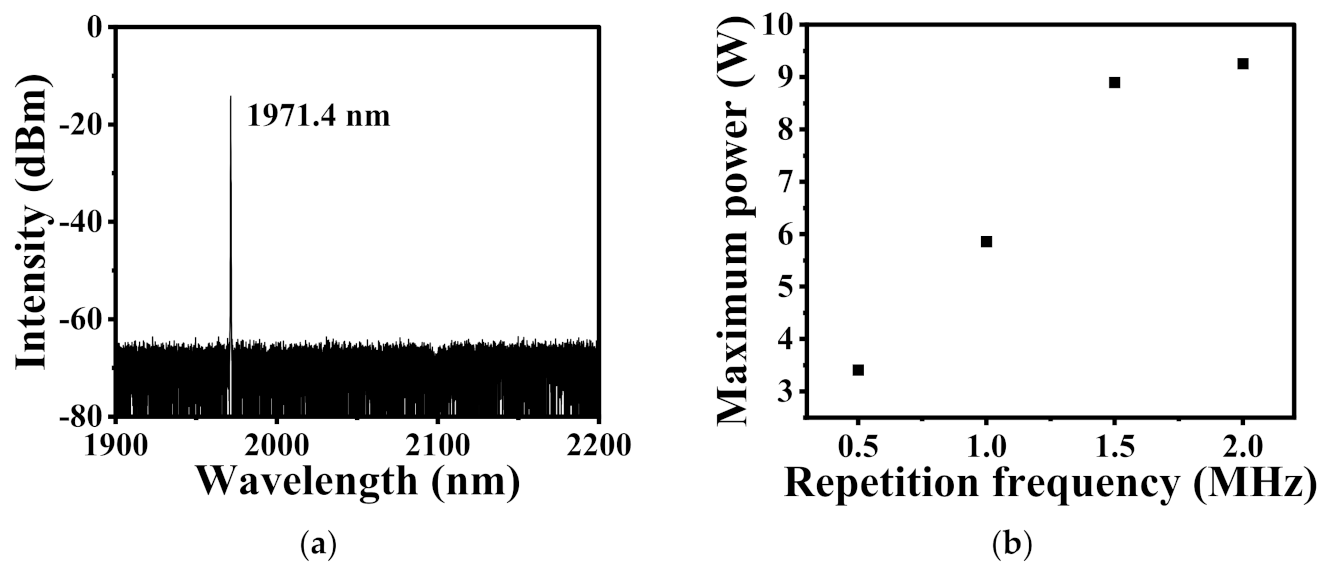

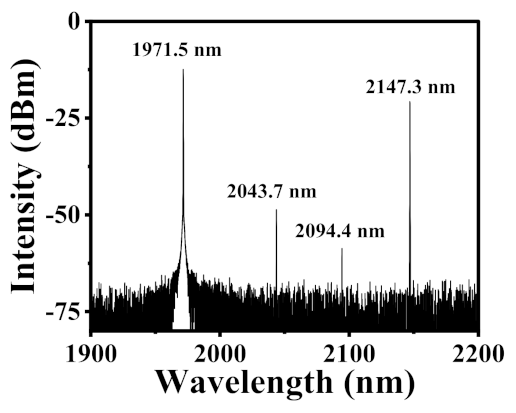
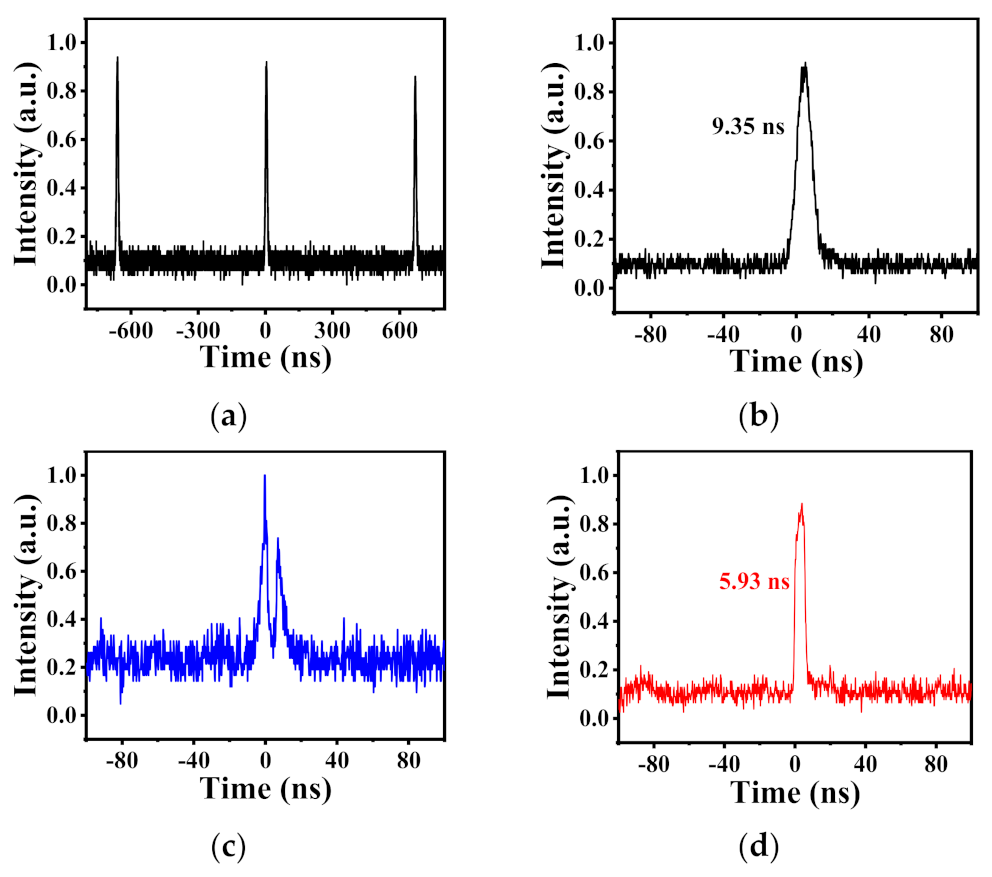
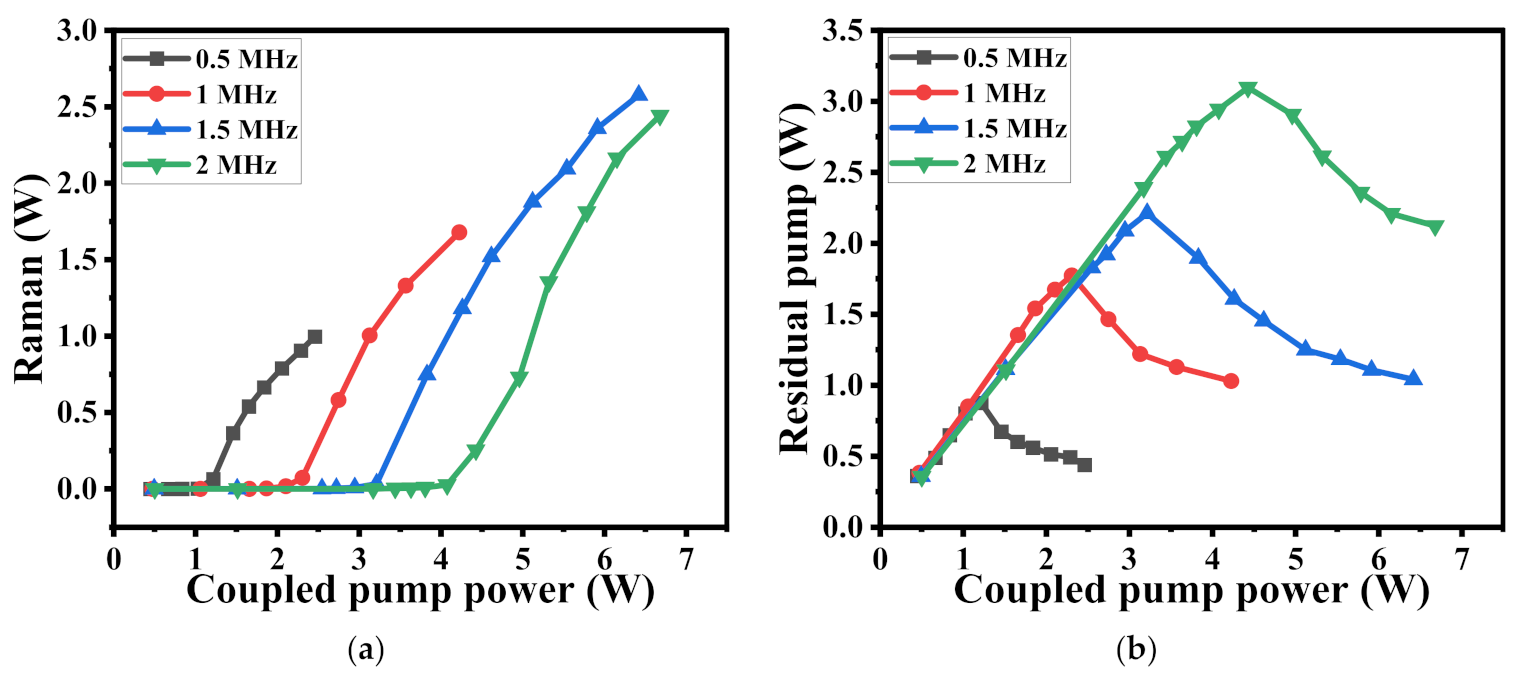
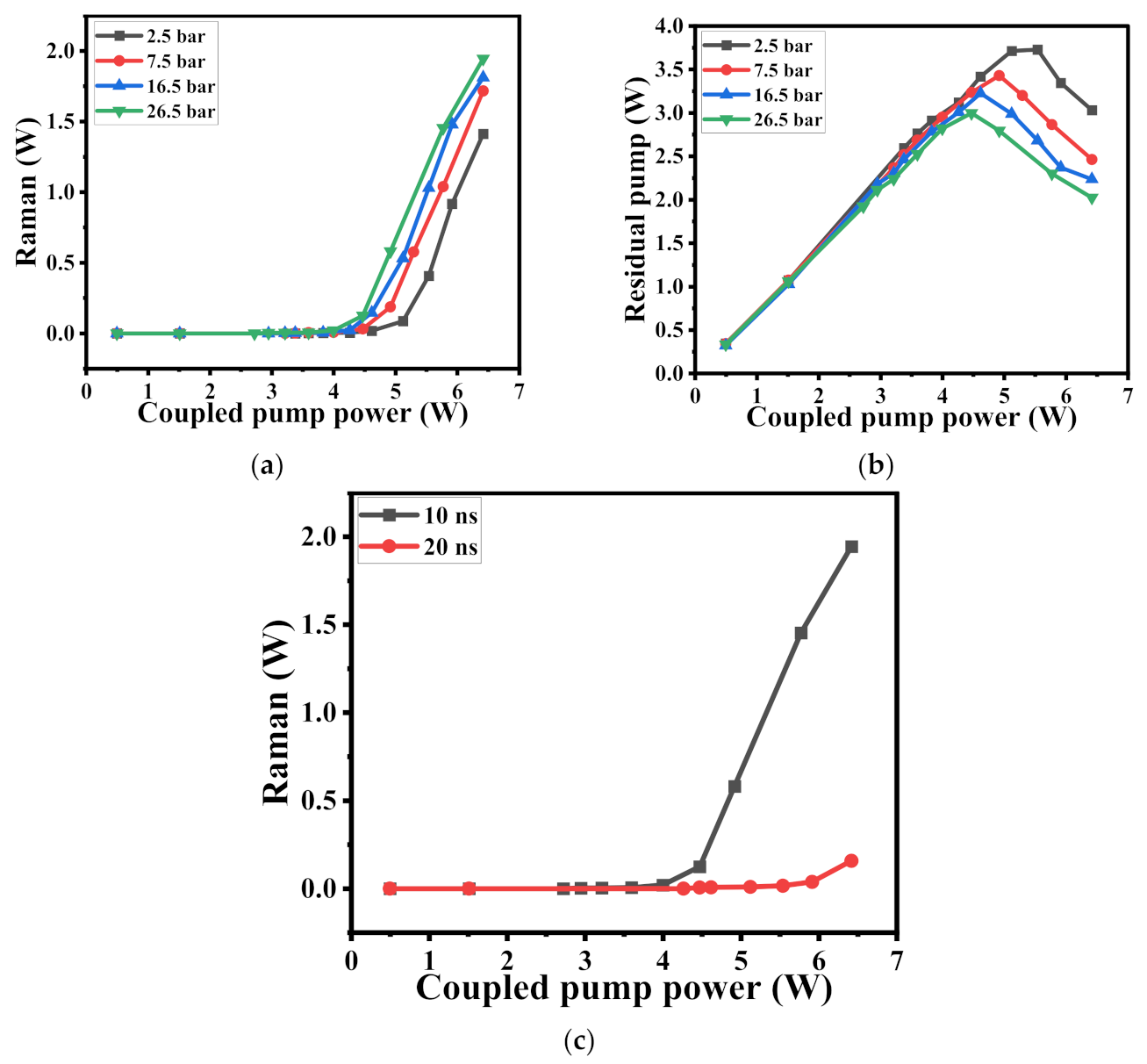
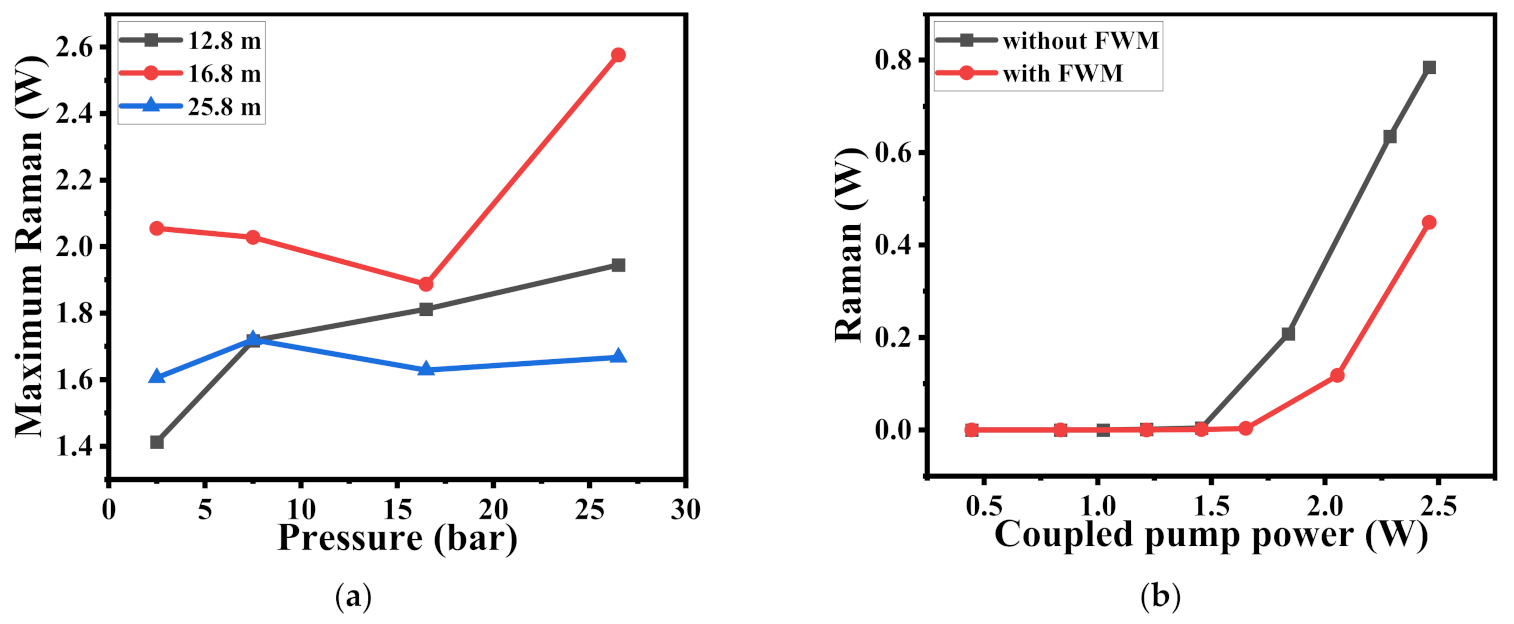
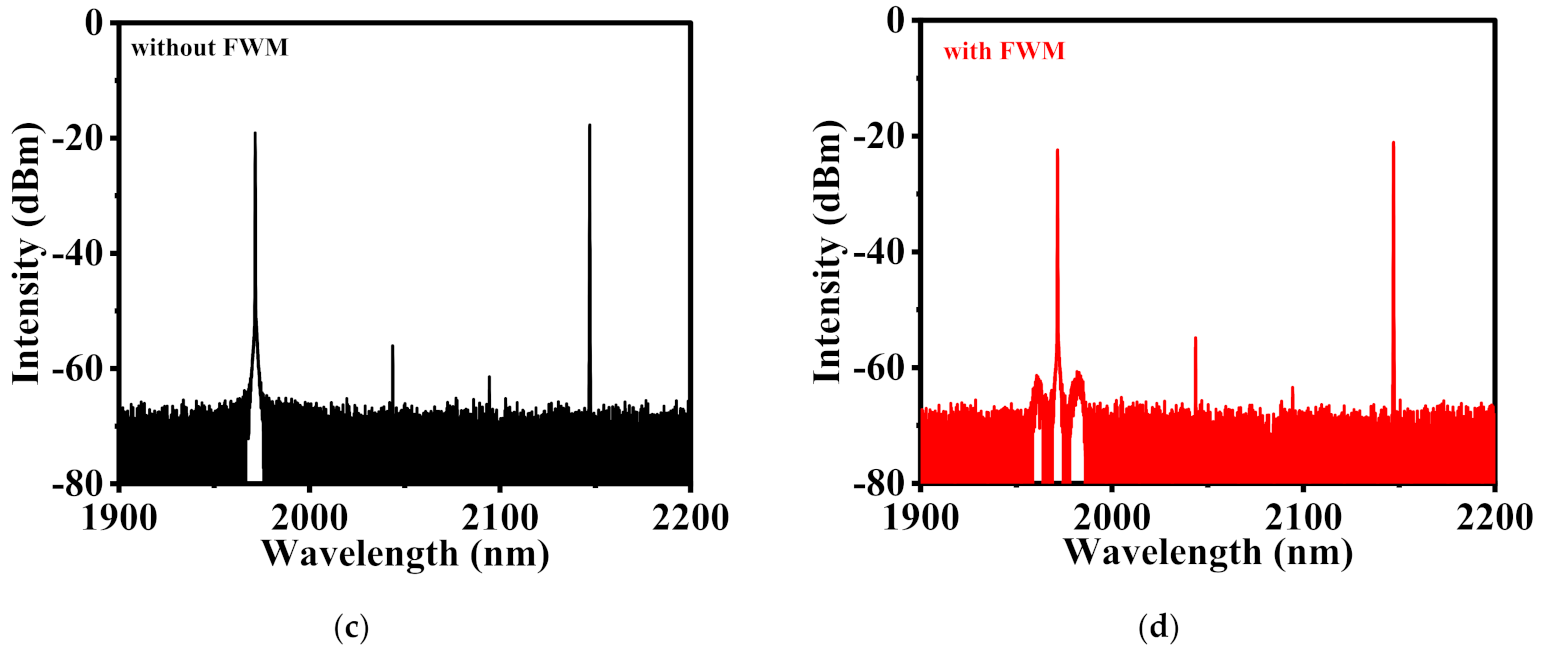
Publisher’s Note: MDPI stays neutral with regard to jurisdictional claims in published maps and institutional affiliations. |
© 2022 by the authors. Licensee MDPI, Basel, Switzerland. This article is an open access article distributed under the terms and conditions of the Creative Commons Attribution (CC BY) license (https://creativecommons.org/licenses/by/4.0/).
Share and Cite
Li, Z.; Pei, W.; Li, H.; Huang, W.; Li, X.; Wang, Z.; Chen, J. D2-Filled Hollow-Core Fiber Gas Raman Laser at 2.15 μm. Photonics 2022, 9, 753. https://doi.org/10.3390/photonics9100753
Li Z, Pei W, Li H, Huang W, Li X, Wang Z, Chen J. D2-Filled Hollow-Core Fiber Gas Raman Laser at 2.15 μm. Photonics. 2022; 9(10):753. https://doi.org/10.3390/photonics9100753
Chicago/Turabian StyleLi, Ziyan, Wenxi Pei, Hao Li, Wei Huang, Xuanxi Li, Zefeng Wang, and Jinbao Chen. 2022. "D2-Filled Hollow-Core Fiber Gas Raman Laser at 2.15 μm" Photonics 9, no. 10: 753. https://doi.org/10.3390/photonics9100753
APA StyleLi, Z., Pei, W., Li, H., Huang, W., Li, X., Wang, Z., & Chen, J. (2022). D2-Filled Hollow-Core Fiber Gas Raman Laser at 2.15 μm. Photonics, 9(10), 753. https://doi.org/10.3390/photonics9100753



